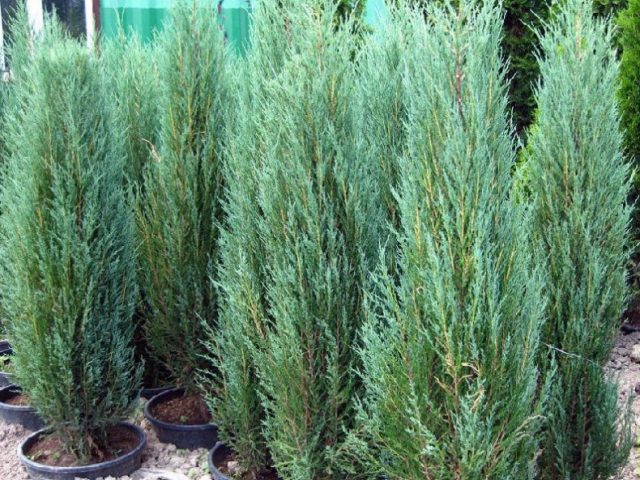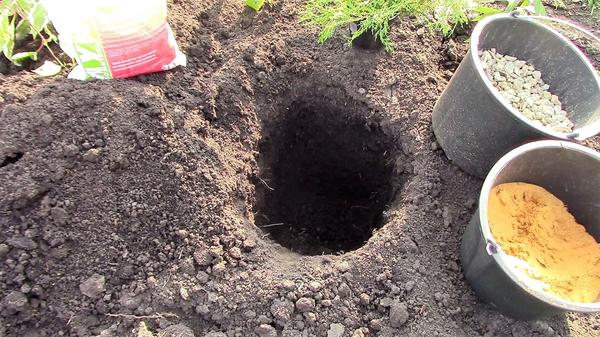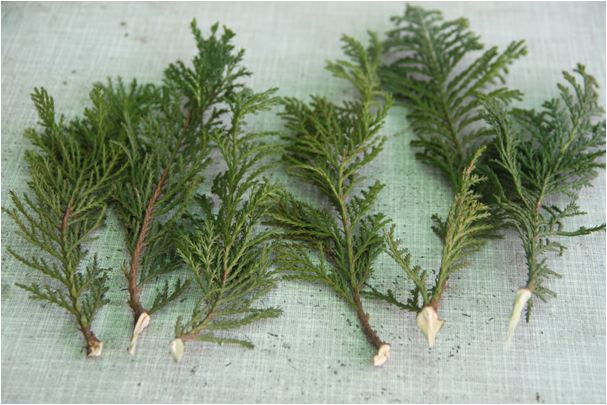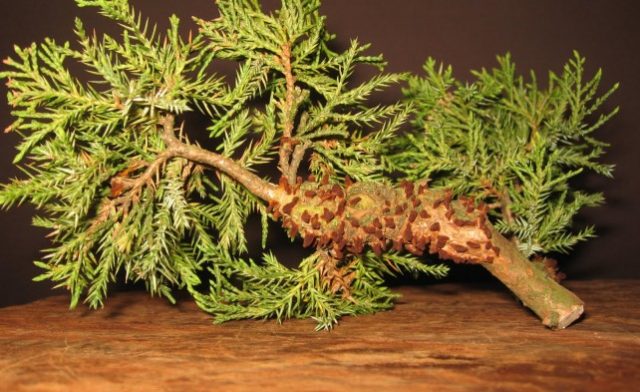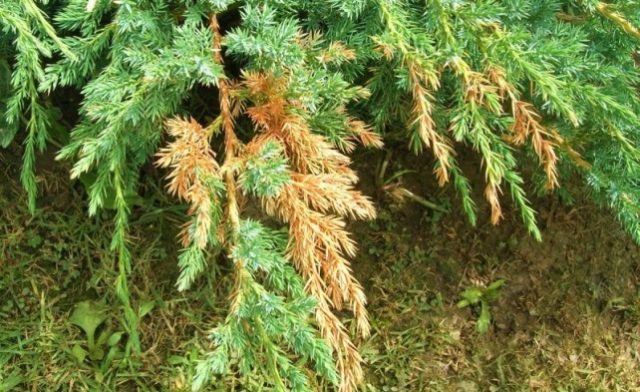Content
Juniper is a coniferous evergreen plant widespread in northern and western Europe, Siberia, North and South America. Most often it can be found in the undergrowth of a coniferous forest, where it forms dense thickets. The article provides a description and photo of Arnold juniper - a new columnar variety used for landscaping land plots, park areas and sanatoriums.
Description of common juniper Arnold
Common juniper Arnold (Juniperus communis Arnold) is a slow-growing coniferous tree of the cypress family with a columnar crown. Its branches are directed vertically, tightly pressed against each other and rush upward at an acute angle. Needle needles 1.5 cm long have a green, dark green or green-blue color. In the second or third year, cones ripen, which have a black-blue color with a white-blue bloom. Juniper cones are conditionally edible and have a sweetish taste. The size of one fruit ranges from 0.5 to 0.9 mm, 3 brown seeds ripen inside (sometimes 1 or 2).
In a year, the Arnold juniper grows by only 10 cm, and by the age of ten its growth is 1.5 - 2 m with a crown width of about 40 - 50 cm.This ornamental tree is classified as a dwarf tree, since it rarely grows above 3 - 5 meters.
Arnold common juniper in landscape design
In landscape design, Arnold juniper is used to create alpine slides, coniferous alleys, a Japanese garden, hedges or heather slopes. The beauty of this variety lends sophistication to parks and is also often used in garden design. The plant is planted both in single compositions and in row plantings in mixed groups.
Planting and caring for Arnold juniper
Planting and caring for Arnold common juniper is not particularly difficult. The plant loves sunny areas, feels good in light shade, and in a dense shade, the color of the needles turns pale, the crown is poorly formed. It is desirable that the sun's rays illuminate the juniper throughout the day, the density and growth rate of the needles depends on this.
Arnold does not tolerate harassment, therefore it requires a lot of space - the distance between the seedlings should be 1.5 - 2 m.This juniper variety does not have special soil requirements, but it grows better in drained, sandy loam, moist soils with acidity values from 4.5 up to 7 pH. He does not like clay, stagnant soils, therefore, drainage and sand must be added to the root pit during planting.
Juniper Arnold does not feel well in a gas-polluted area, therefore it is more suitable for growing in personal plots.
Seedling and planting plot preparation
Juniper seedlings with an earthen clod are soaked in water for two hours before planting - for good impregnation. A seedling with an open root system is treated with a rooting stimulant, for example, Kornevin.
Planting pits are prepared in late April, early May, or in the first half of autumn. The width and depth of the hole should be 3 times the earthen coma.A drainage layer of 20 cm from sand or crushed stone is laid out on the bottom.
Landing rules
An earthen mixture is prepared from 2 parts of leafy soil, one part of sand and one part of peat. When planting, it is important to ensure that the root collar does not remain buried in the soil. It should be 5-10 cm higher than the pit edges in adult plants and level with the soil in young seedlings. If you deeply deepen or raise the neck, Arnold juniper may not take root and die.
Watering and feeding
Arnold variety does not tolerate dry air. After planting, the seedlings should be watered once or twice a week for a month, depending on the weather. One plant should consume at least 10 liters of water. If the weather is dry and hot, it is recommended to additionally sprinkle each tree, since the needles evaporate a lot of moisture. Juniper Arnold is drought-resistant and requires watering no more than 2 - 3 times per season (approximately 20 - 30 liters of water per adult tree). In dry weather, watering is necessary 1 - 2 times a month.
Top dressing is carried out once a year at the beginning of May with Nitroammofoskoy (40 g per sq. M.) Or water-soluble fertilizer "Kemira Universal" (20 g per 10 l of water).
Mulching and loosening
Twice a year, in autumn and early spring, the soil must be mulched with a layer of compost 7-10 cm high. For better growth, it is recommended to loosen the soil in the area of the root circle regularly, at least once every two weeks.
Trimming and shaping
Juniper Arnold tolerates a haircut well. Pruning is carried out once a year, in early spring, and is reduced to the removal of dry, diseased or damaged branches. This is done to stimulate the growth of new shoots, from which the crown is formed. Since Arnold juniper grows very slowly, it should be cut carefully, taking care not to damage healthy branches.
Preparing for winter
Juniper is a frost-hardy plant that can withstand temperatures as low as -35 ° C. However, this columnar species does not tolerate snowfalls well, therefore it is recommended to tie the crown with rope or tape for the winter. Young plants in the fall are sprinkled with a 10-centimeter layer of peat and covered with spruce branches.
Reproduction
Common juniper Juniperus communis Arnold can be propagated in two ways:
- Seeds. This method is considered the most difficult. Only freshly harvested seeds are suitable for him. Before planting, the seeds are scarified (the outer layer is disturbed by exposure to cold for 120 - 150 days). This is done because of their dense shell - to facilitate germination. Then they are planted in the ground and watered as the earthen coma dries.
- Semi-lignified cuttings. The most common way. In the spring, a young shoot of a juniper with a heel (mother fragment) is cut off, planted in a prepared substrate, where it then takes root. The temperature should be at first +15 - 18 ° C, then increase to +20 - 23 ° C.
Sometimes the Arnold juniper is propagated by layering, but they rarely resort to this method, since this threatens to disrupt the characteristic shape of the crown.
Diseases and pests
Juniper Arnold is most often exposed to diseases and suffers from pests in the spring, when after winter his immunity is weakened.
Description and photos of common ailments of common juniper Arnold:
- Rust. It is a disease caused by the fungus Gymnosporangium. The affected areas, in which the mycelium is located, thicken, swell and die off. These growths have a bright red or brown tint.
- Tracheomycosis. It is also a fungal infection caused by the fungus Fusarium oxysporum. In this case, the needles of the juniper turn yellow and crumble, and the bark and branches dry out. First, the tops of the shoots die off, and as the mycelium spreads, the whole tree dies.
- Shute brown. The disease is caused by the fungus Herpotrichia nigra and is manifested by yellowing of the shoots. Due to the formed black growths, the needles acquire a brown tint and crumble.
In addition to diseases, Arnold juniper suffers from various pests, such as:
- angle-winged moth: it is a small butterfly, the caterpillars of which feed on needles without damaging the branches of the plant;
- Juniper Scale: the parasite belongs to sucking insects, its larvae stick to the needles, because of which it dries up and dies;
- gall midges: small mosquitoes 1-4 mm in size. Their larvae glue the needles of juniper, forming galls, inside of which the parasites live, causing the shoots to dry out;
- aphid: a sucking parasite that loves young shoots and greatly weakens the plant's immunity;
- spider mite: a tiny insect that feeds on the contents of cells and braids young twigs with a thin cobweb.
In order to prevent diseases, Arnold juniper must be sprayed with phosphate or sulfur preparations, and also fed, watered and mulched in time.
In addition, to reduce the risk of contracting certain fungal infections, junipers should not be planted near fruit trees such as pears. This is due to the fact that mushrooms are pests of various households and move from juniper to pear and vice versa every year. One has only to separate the trees, as the harmful fungus will die in a year.
Conclusion
The above description and photo of Arnold juniper allows us to conclude that this unpretentious plant, with proper care, will delight the eye with its beauty for a long time. It is enough to carry out annual feeding and spraying events - and the juniper will thank you with good growth, as well as healthy, green and fragrant shoots.
